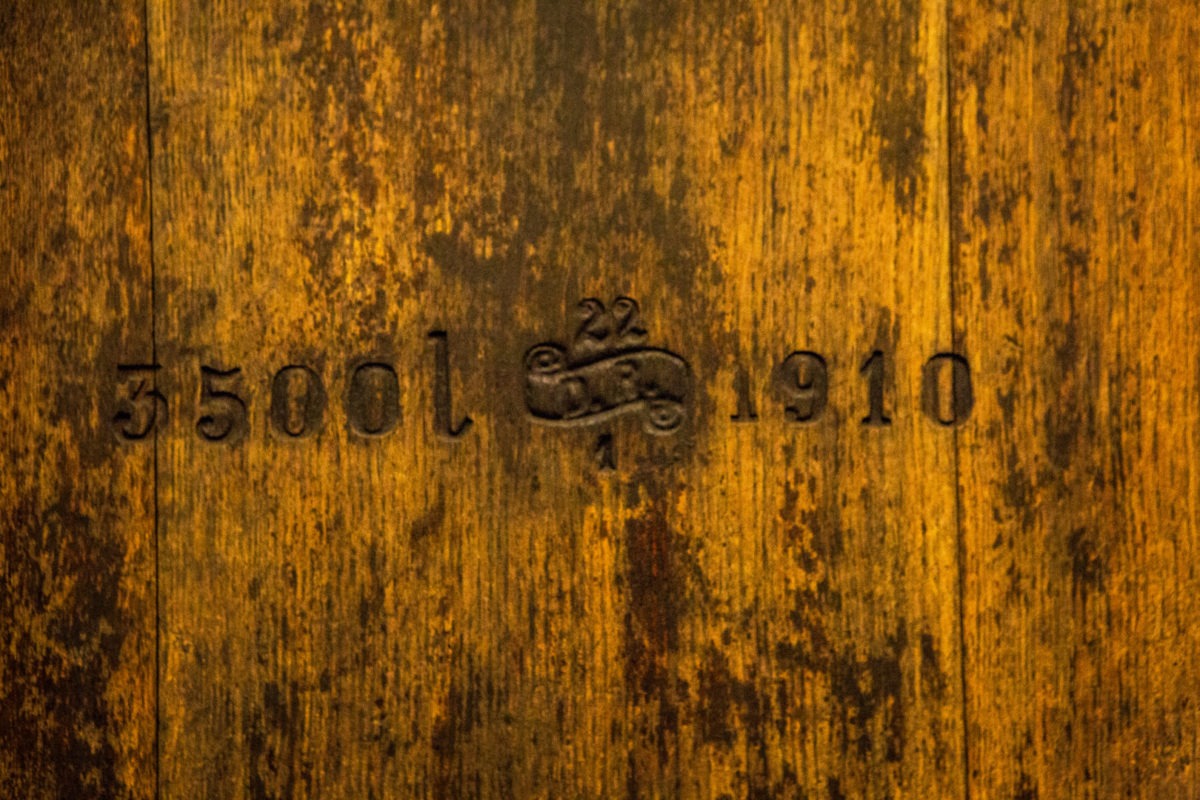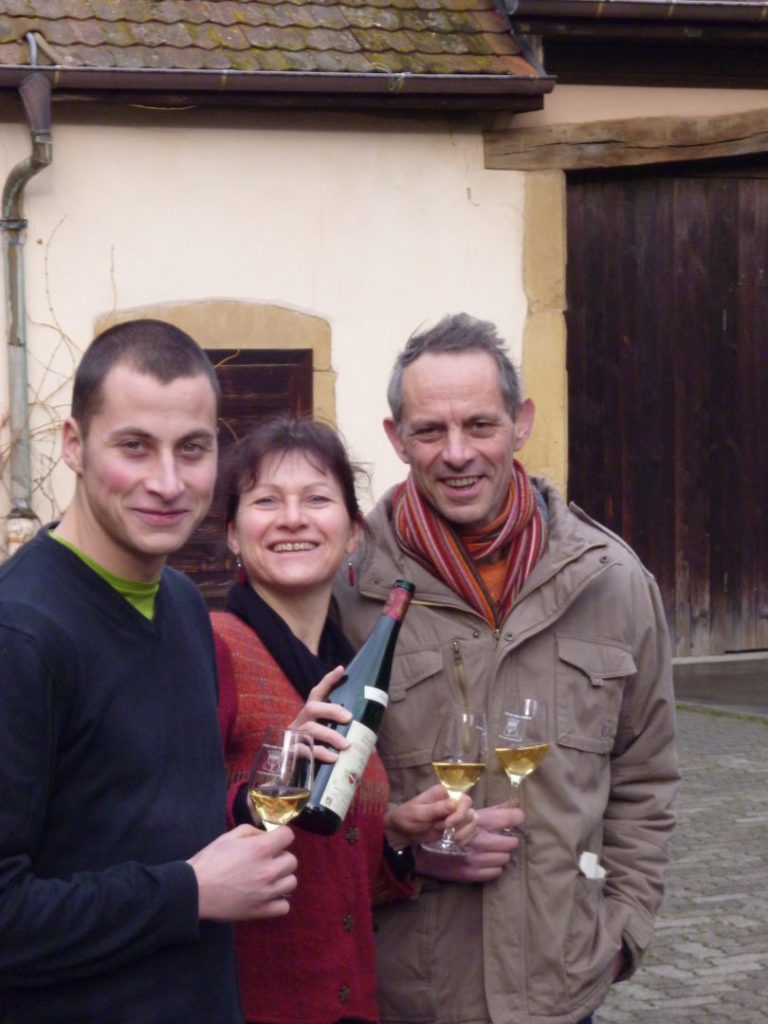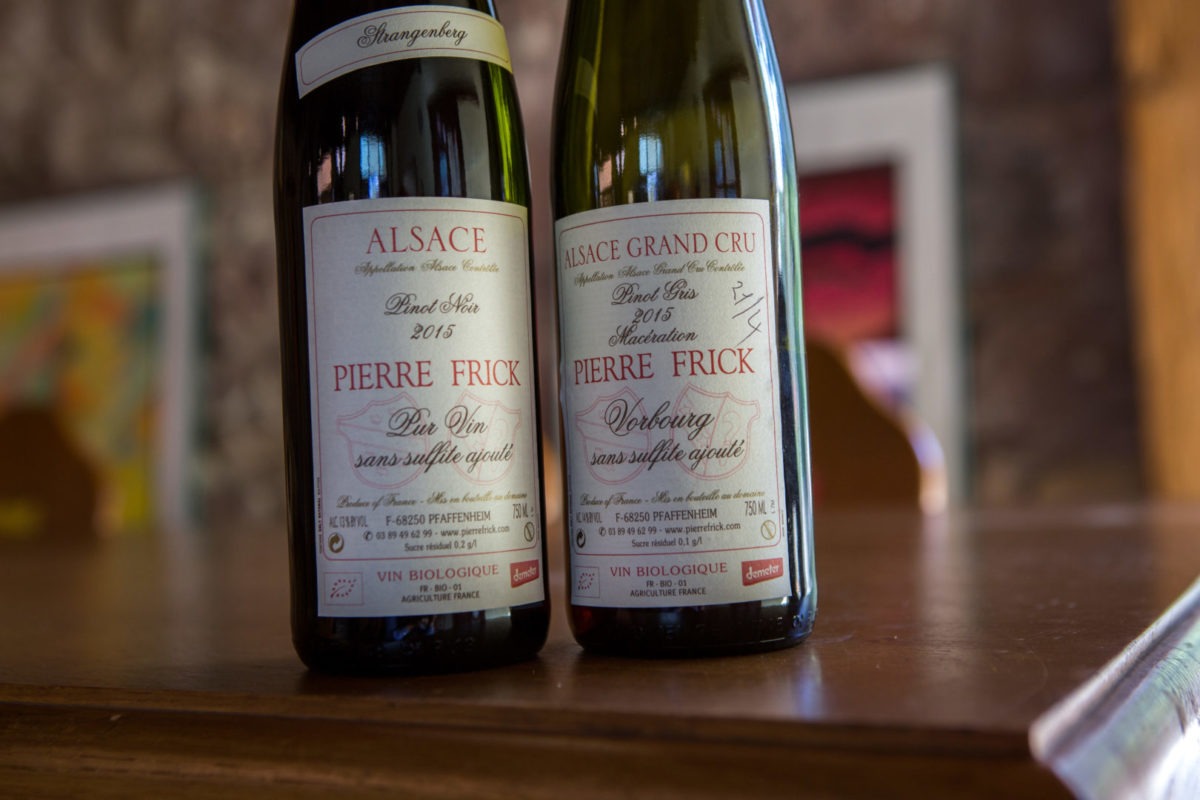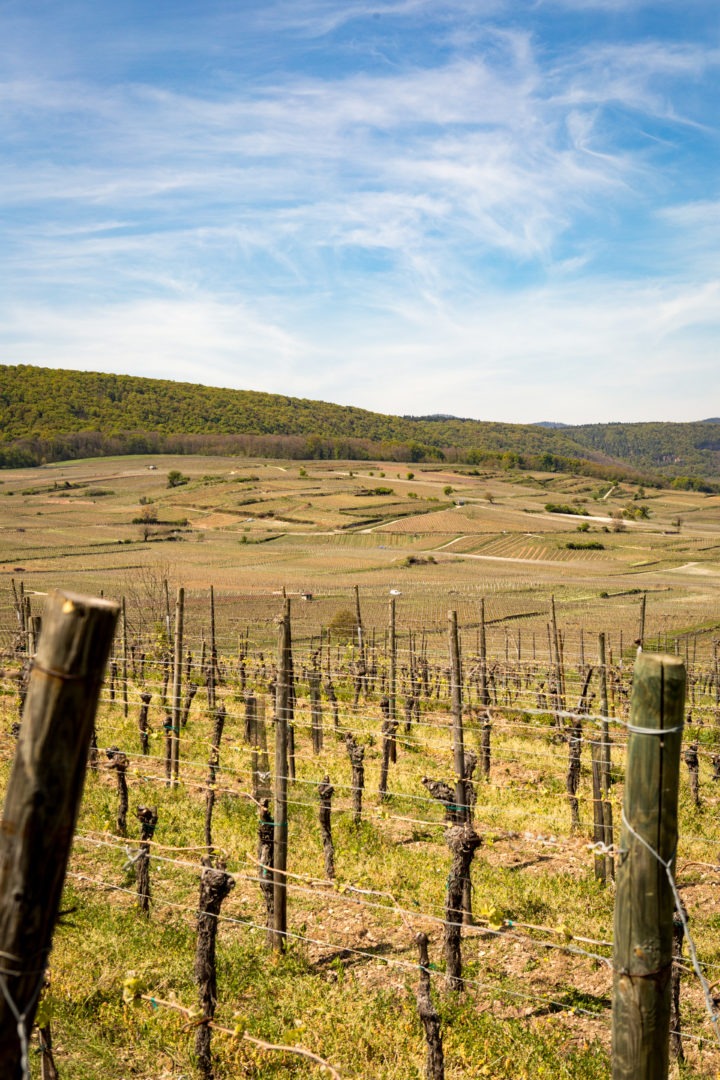Domaine Pierre Frick
Jean-Pierre, Chantal and Thomas Frick – Domaine Pierre Frick – Pfaffenheim
The first thing to say here, is that there is so much going on with ecology militancy, field and cellar work, vineyard sites, grape varieties, a huge range of cuvées and an unflinching connection to nature, that the domaine should be the subject of a thesis.
A brief history in time with Jean-Pierre and Chantal Frick. Here we go ……… Since Roman times, vines have been cultivated in and around the wine village of Pfaffenheim. Cultivated with respect for the soil, the land and the environment. Then, in the second half of the last century, modern industrial agriculture with its promises of productivity and perfection, cast its poisonous spell over the Alsace wine region. A band of pioneers went back to the future and they included Jean-Pierre’s parents who converted their Pfaffenheim vineyards back to organic farming in 1970. Jean-Pierre and Chantal went a step further in 1981, with Demeter biodynamic certification. In 1990’s their first natural wines were produced with minimal intervention in the Frick cellar, including several cuvées with no sulphur added.
This pioneer spirit helped establish an attitude in Alsace, that has now resulted in over 25% of the wine region being farmed organically, or biodynamically. If you want to make good honest wine, start with some good honest fruit.
The bigger picture shows that Jean-Pierre and Chantal Frick are activists in many areas of the ecology movement in Alsace and beyond. Ranging from disrupting genetically modified, experimental vine plots, to campaigning for the closure of regional, nuclear power plants. Jean-Pierre is also one of the two founders of the Foire Eco Bio Alsace. This started way back in 1982 and is now staged each May, in Colmar. The fair is one of the key happenings in the Ecology Movement calendar, now attracting around 45,000 attendees, with a range of conferences and events and of course, an integrated winemakers’ section. With Domaine Pierre Frick in attendance and pouring wine every year.
Together with Christian Binner, Bruno Schueller and Patrick Meyer, Jean-Pierre is one of the Alsace ‘gang of four’, tagged in French as ‘Les Quatre Mousquetaires’. This group set the foundations for natural wine in Alsace and a cornerstone was the organisation of Le Salon des Vins Libres back in 2008. This is a biannual fair held in the month of May. In attendance are 60-70 producers mostly from the other French regions. This physical event has provided a marker and assembly point for natural wine enthusiasts to gather. Starting in 2016, the salon introduced a showcase “off” section, featuring the growing band of younger Alsace natural wine producers.


The Domaine :
Back to the Frick Domaine, where around 70,000 bottles are produced each year from twelve hectares of vineyards. About 50% of production goes to export each year, with the principle destinations being Japan, Italy, Canada and the UK.
The numerous plots span 10 kilometers running north to south, sprinkled and clustered along the slopes that run up to the forests of the Vosges. These plots make up a real bag of jewels; situated on three Grand Cru sites and seven lieux-dits (place name sites). The three Grand Cru’s are all sun baked with a hot and dry climate.
Five of the lieu-dit sites have Premier Cru dossiers currently under review by the INAO, the French national institute for product origins and quality. This is part of the initiative to expand vineyard site classification in Alsace.
Now, with 10 distinct sites coupled with the range of grape varieties planted in Alsace, it is not difficult to figure out that a significant number of cuvées are produced every year. On our visits to the domaine and also when we catch Jean-Pierre at a wine fair, we expect to taste around 15 different wines. Sometimes we get to taste something very special from a bottle, like a 1992 Pinot Gris, Grains Nobles and sometimes it’s a Sylvaner straight from the foudre with its sugars still fermenting away.
Fruit is all hand-picked and is either macerated or slow pressed in the cellar, with indigenous yeasts spontaneously kicking in the fermentations. Cellar work is done on a cuveé by cuveé basis, with any incomplete fermentations left to restart again when the spring warms the cellar. Fermentation and maturation take place in large traditional oak foudres that range in size up to 4,000 liters.
I had an interesting discussion with Jean-Pierre on white grape maceration and on where and when that (re)started in Alsace. That topic will be the subject of a future article.

Pinot Noir from the Strangenberg and Pinot Gris from the Vorbourg
The vineyards and varieties
The furthest north of the vineyard plots is on the Eichberg Grand Cru at Eguisheim, which is really at the southern end of the Alsace wine region. The Eichberg with its gravelly layer of sandstone and marl has a big reputation for Gewürztraminer and that’s the only variety Jean-Pierre grows here. Funnily enough I have never tasted an example and that’s on our list of must do’s. Nothing like starting off some tasting notes with a wine I’ve never had. Now that’s radical.
Moving south with the Grand Cru vineyards and we land in the Steinert, just west of Pfaffenheim. As you would expect from the name, the Steinert has a dry stony soil and that sits on a limestone base. We have had pale lemon, bone dry Muscat from the Steinert, which was all grapes on the bouquet and complex floral layers on the palate. Also, Gewürztraminers from different years that were discrete and controlled, with their 4-8 grams of residual sugar nicely held in check with the acidity. The Rieslings we have tasted have had that theme where the tight, nervous, vertical aspects are tugged by the natural wine approach, to give wines that are more unctuous and rounder. A favourite Riesling year is 2013 and the acidity level and ultra-long finish in that cuveé, bodes well for a wine that will age well.
The third stop Grand Cru vineyard is the Vorbourg west of Rouffach, where the domaine produces Riesling and Pinot Gris. Another hot and dry climate location pushes these varieties into more exotic expressions. The Riesling’s can have toasty notes and ripe fruits on the palate, and we picked up ripe quince on the 2014. The Pinot Gris can get really exotic with ripe peaches and apricots on the palate. For both these varieties some great work is done in pulling them in to be light and fresh, and the élevage on the lees in large foudres encourages delicious, lingering, saline finishes. That saline minerality works so well with these wines that have a tendency towards the exotic.

Here we go with the lieux-dits sites, approximately running north to south.
The Bergweingarten (the wine garden on the hill), butts on to the north end of the Steinert. This is where the Frick Sylvaner comes from. The Premier Cru dossier includes Sylvaner and Gewurztraminer from this vineyard. We have pretty consistent tasting notes on the 2012, 2013 and 2016 Sylvaners. The wines were clear, with white peach, white flowers and agrumes on the palate. There is a touch of sweetness that makes this a great wine for food pairings, and we had the 2013 with Baeckaofa at a tasting dinner at Terroirs in London. This is another cuveé for Back-In-Alsace to follow, as we are big, big, Sylvaner fans.
Heading south to the Bihl vineyard which is across the main road and to the east of Pfaffenheim. The Bihl is a hill that sits up on the plain and faces west, which is quite an unusual exposure in Alsace. This is another Premier Cru site, for Riesling this time, and Jean-Francois Ginglinger and Domaine Rieflé also work this vineyard. West facing means it misses out on the morning sun, gets blasted in the afternoon and is hit with cooling winds from the Vosges in the evening. The thin calcaire soil is fast draining and this often leads to hydric stress. The Rieslings from the Bihl are sharp and crystalline with loads of minerality that often comes from this type of terroir.
Further south and just next to the town of Rouffach, is the high plain vineyard of Rot Murlé. The calcaire, iron based, reddish soils give the vineyard its Rot (red) name. Here, there is Riesling and most definitely Pinot Noir. Again, hydric stress and the climate drive low yields and up the concentration of the grape juice. The Riesling’s are fresh and croquant. The Pinot Noir tends to have that fragile tension which holds the baked fruits precisely in place. The high plain topography of the site allows all day sunshine, which is not as intense as some of the suntraps on steeper sloped vineyards. The Premier Cru dossier for this vineyard is in the most advanced batch, currently under consideration at the INAO.
The next jewel out the bag is the Lerchenberg vineyard, which sits to the north east of the Rot Murlé. The Premier Cru dossier for this vineyard is unusual in that it promotes a cremant and the Frick’s grow Auxerrois, Pinot Blanc and Pinot Noir. We have not seen the Premier Cru file, so not sure if specific ratios/blends are set out. I have tasted several cremants from the domaine and was unaware if any were specifically from the Lerchenberg site.
The Strangenberg vineyard is the furthest west of the sites, close to Westhalten and on the road to the Zinnkoepflé Grand Cru. This is another hill site, with limestone soils on east facing slopes, running up to 320 meters. Like the Zinnkoepflé, this site has a Mediterranean type of flora and fauna based on its hot, dry summer climate. The Fricks produce Pinot Noir here, and the Premier Cru dossier lists twelve producers. We recently had the 2015 Pinot Noir which was deep ruby in colour, with complex baked griotte on the palate and a forest floor undertone, providing a lively complexity.
Also, at Westhalten is the Grosstein vineyard, and the last lieu-dit is the east facing Carrière vineyard sitting above the Vorbourg Grand Cru and directly west of Rouffach. The Grosstein with its clay soils is a Pinot Noir site and the two-hectare Carrière produces Auxerrois, Riesling and Gewurztraminer, on a rare yellow sandstone soil. We haven’t had any named wines from these sites and that will have to be part of the next discovery trip to the Frick’s.
Last but not least is an elusive Chasselas cuveé, quite hard to find unless you are in London or Quebec where it all goes for export. This wine is from a small 0.5 hectares plot on the Carrière site, with only 2000-3000 bottles produced each year.
That wraps up our first pass for the domaine profile and we are looking forward to the next field-study trip to Pfaffenheim, where we can continue our devoir.
Domaine PIERRE FRICK
70,000 bottles
12 hectares
5, rue Baer
68250 PFAFFENHEIM
+33 3 89 49 62 99
Email: [email protected]
Website: https://www.pierrefrick.com/

Up on the Rot Murlé looking north-west to the Vosges forests


